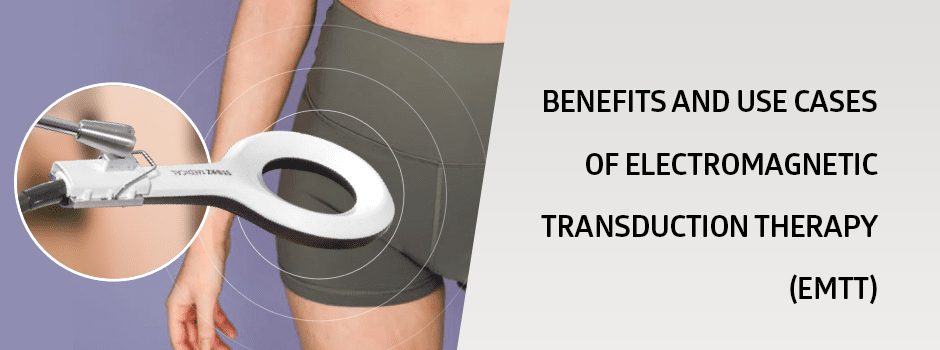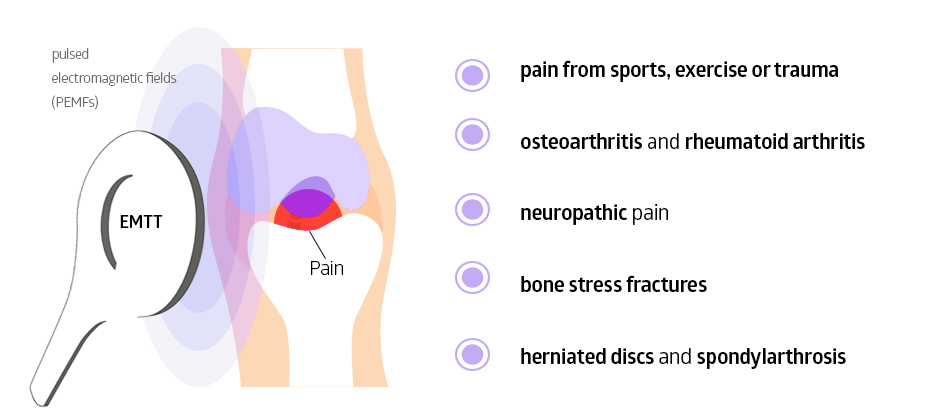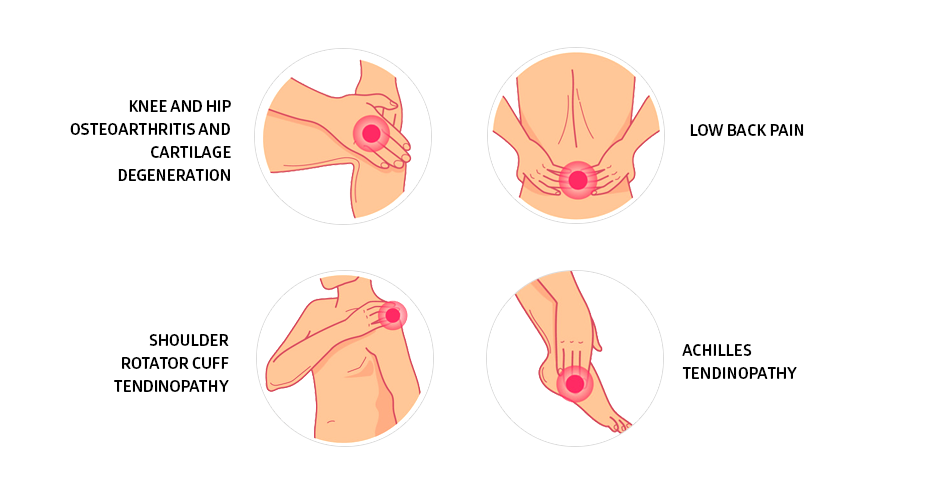
Electromagnetic transduction therapy (EMTT) is a new technology for treating musculoskeletal pain and tissue degeneration. It offers a promising non-invasive alternative to traditional treatment methods that rely on drugs, invasive procedures and surgery.
Learn more about how EMTT therapy works to eliminate pain and accelerate healing in a variety of use cases.
Extracorporeal Magnetic Transduction Therapy is an advanced form of regenerative healing technology that uses pulsed electromagnetic fields (PEMFs) to emit short duration high-speed impulses to evoke an electrophysical reaction in damaged cells.
The pulsed energy triggers the body’s innate healing mechanisms, jump-starting the healing process in degenerative joints and connective tissues, and dramatically reducing pain. EMTT is often used in conjunction with extracorporeal shockwave therapy (ESWT) to optimize treatment outcomes.

EMTT therapy is effective in treating a broad spectrum of pain syndromes, including:
Acute inflammatory pain from sports, exercise or trauma
Degenerative joint pain from osteoarthritis and rheumatoid arthritis
Neuropathic pain
Pain from bone stress fractures and non-unions
Back pain from herniated discs and spondylarthrosis
In addition to alleviating pain, EMTT helps to stimulate healing in damaged tissues by encouraging the repair of individual cells and the genesis of new ones. The magnetic pulses emitted by EMTT send magnetic energy into the body’s cells and resonate with the body’s own magnetic fields, increasing available electrolytes and ions. The resulting increased electrical activity sparks cellular metabolism, to initiate the healing process.
The past decade has seen a wave of new regenerative technologies that leverage the body’s innate healing mechanisms. Rather than intervening in tissue repair, regenerative technologies work in tandem with cellular metabolism, clearing a path for natural healing. Extracorporeal Magnetic Transduction Therapy is just one of several regenerative treatment options, and is often used in conjunction with other non-invasive therapies.

EMTT has multiple advantages, including:
Does not require anesthesia
Needs no downtime for recovery
Patient immobilization is unnecessary
Performed as an outpatient procedure
Completely non-invasive and painless
Penetrates deep tissues
Sessions take 15-20 minutes
Only 4-8 treatment sessions required
Rather than spending weeks or months with restricted mobility while taking harmful medications to mask the pain, patients report reduced pain after the very first session, and complete recovery after several brief sessions.
Osteoarthritis (OA) is a debilitating joint condition characterized by cartilage degeneration, osteophyte formation and stiffening of the joints. Degeneration of bone and joint cartilage in OA is attributed to an imbalance between the breakdown and synthesis of chondrocytes that regulate turnover in the extracellular matrix (ECM). Recent research indicates that PEMFs such as EMTT are effective in preventing the development of osteoarthritis and halting its progression.
Researchers randomly assigned 86 patients with rotator cuff tendinopathy to one of two study groups. One group was treated with extracorporeal shockwave therapy (ESWT), while the other group was treated with both ESWT and EMTT. The patients treated with EMTT saw significant improvements in both pain and shoulder function compared to the ESWT-only group.

Low back pain (LBP) is one of the most common medical complaints of adults, yet it often arises with no evidence of structural damage to the spine. Non-specific LBP is often treated with rest, pain medications, and anti-inflammatory drugs, and often resolves itself over time. However, a recent study found that treatment of non-specific LBP with EMTT was significantly superior to conventional treatment alone.
A study involving 53 patients with chronic Achilles tendinopathy provided all patients with heel cushions, but also gave 28 patients eight treatments of EMTT therapy over a 4-week period. At the 12-week assessment point, the patients who had been treated with EMTT showed significant improvements over the control group.
These are just a few of dozens of studies that show EMTT therapy to be an effective treatment option for musculoskeletal pain and tissue degeneration. The field of regenerative medicine shows great promise for helping patients to move away from harmful drugs and surgery by stimulating and supporting the body’s own healing mechanisms.
At NYDNRehab, we use the Storz Magnetolith EMTT device to provide alternative non-invasive therapy to patients suffering from a broad range of musculoskeletal conditions. Our regenerative technologies are rarely found in run-of-the-mill physical therapy clinics. If you want fast pain relief and accelerated healing without harmful drugs or surgery, contact NYDNRehab today, and see what a difference non-invasive EMTT therapy can make.
Research at NYDNRehab
Dr. Lev Kalika is a world-recognized expert in musculoskeletal medicine. with 20+ years of clinical experience in diagnostic musculoskeletal ultrasonography, rehabilitative sports medicine and conservative orthopedics. In addition to operating his clinical practice in Manhattan, he regularly publishes peer-reviewed research on ultrasound-guided therapies and procedures. He serves as a peer reviewer for Springer Nature.
Dr. Kalika is an esteemed member of multiple professional organizations, including: